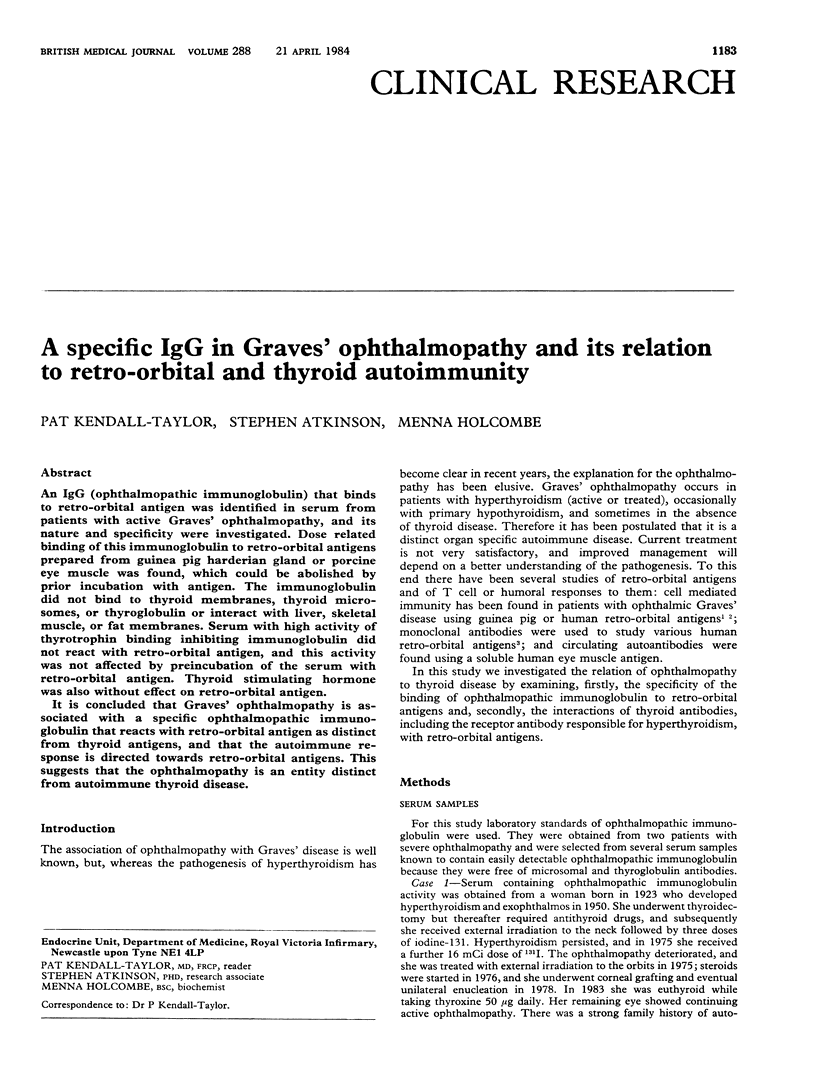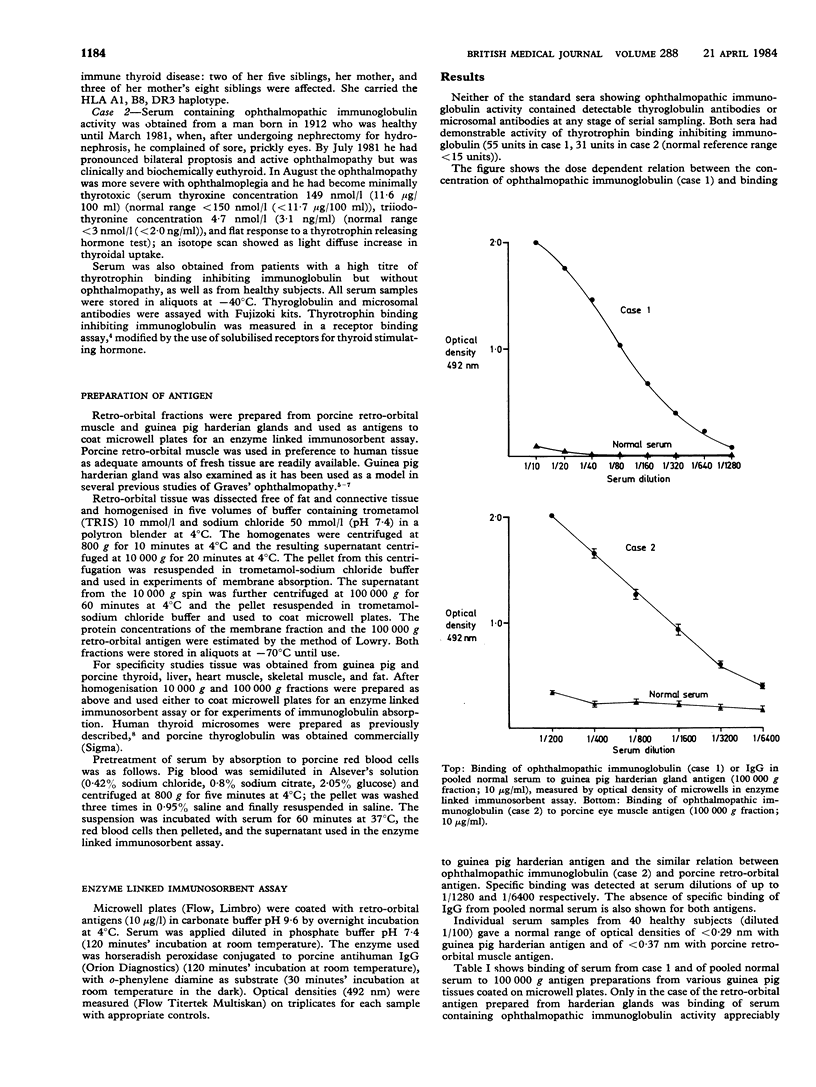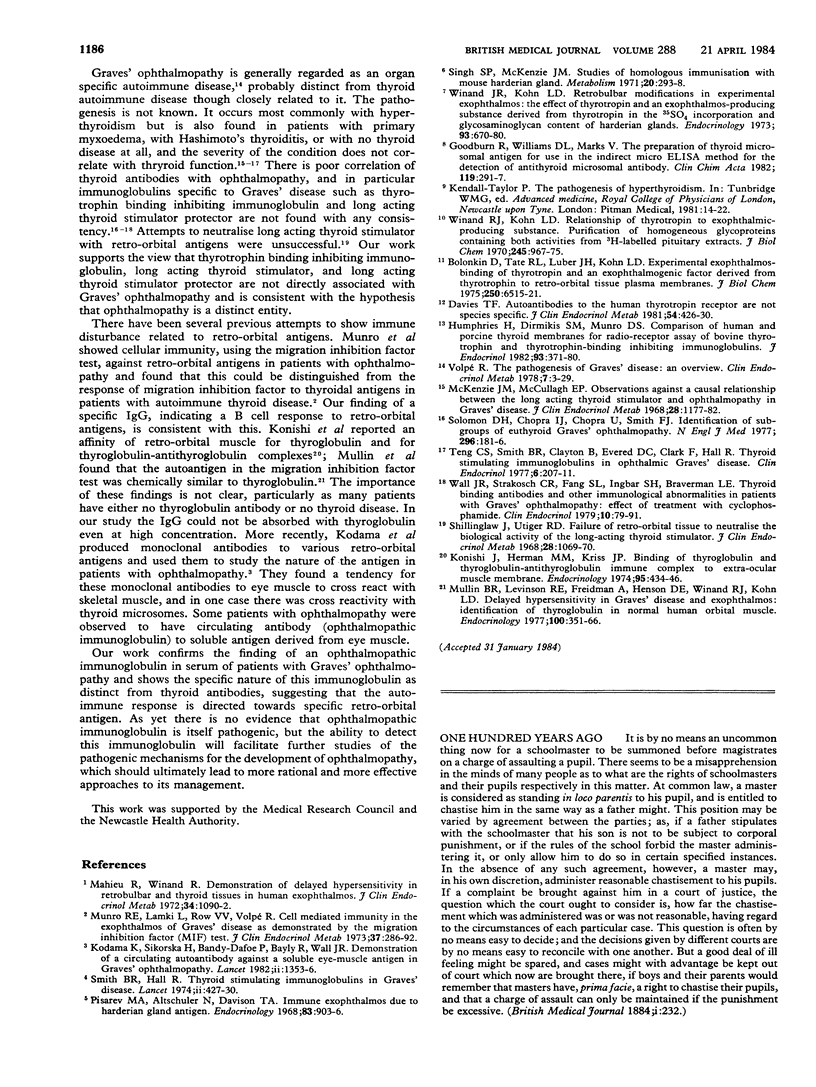Abstract
An IgG (ophthalmopathic immunoglobulin) that binds to retro-orbital antigen was identified in serum from patients with active Graves' ophthalmopathy, and its nature and specificity were investigated. Dose related binding of this immunoglobulin to retro-orbital antigens prepared from guinea pig harderian gland or porcine eye muscle was found, which could be abolished by prior incubation with antigen. The immunoglobulin did not bind to thyroid membranes, thyroid microsomes, or thyroglobulin or interact with liver, skeletal muscle, or fat membranes. Serum with high activity of thyrotrophin binding inhibiting immunoglobulin did not react with retro-orbital antigen, and this activity was not affected by preincubation of the serum with retro-orbital antigen. Thyroid stimulating hormone was also without effect on retro-orbital antigen. It is concluded that Graves' ophthalmopathy is associated with a specific ophthalmopathic immunoglobulin that reacts with retro-orbital antigen as distinct from thyroid antigens, and that the autoimmune response is directed towards retro-orbital antigens. This suggests that the ophthalmopathy is an entity distinct from autoimmune thyroid disease.
Full text
PDF



Selected References
These references are in PubMed. This may not be the complete list of references from this article.
- Davies T. F. Autoantibodies to the human thyrotropin receptor are not species specific. J Clin Endocrinol Metab. 1981 Mar;52(3):426–430. doi: 10.1210/jcem-52-3-426. [DOI] [PubMed] [Google Scholar]
- Goodburn R., Williams D. L., Marks V. The preparation of thyroid microsomal antigen for use in the indirect micro-ELISA method for the detection of anti-thyroid microsomal autoantibody. Clin Chim Acta. 1982 Mar 12;119(3):291–297. doi: 10.1016/0009-8981(82)90342-4. [DOI] [PubMed] [Google Scholar]
- Humphries H., Dirmikis S. M., Munro D. S. Comparison of human and porcine thyroid membranes for radioreceptor assay of bovine thyrotrophin and thyrotrophin-binding inhibiting immunoglobulins. J Endocrinol. 1982 Jun;93(3):371–380. doi: 10.1677/joe.0.0930371. [DOI] [PubMed] [Google Scholar]
- Kodama K., Sikorska H., Bandy-Dafoe P., Bayly R., Wall J. R. Demonstration of a circulating autoantibody against a soluble eye-muscle antigen in Graves' ophthalmopathy. Lancet. 1982 Dec 18;2(8312):1353–1356. doi: 10.1016/s0140-6736(82)91267-3. [DOI] [PubMed] [Google Scholar]
- Konishi J., Herman M. M., Kriss J. P. Binding of thyroglobulin and thyroglobulin-antithyroglobulin immune complex to extraocular muscle membrane. Endocrinology. 1974 Aug;95(2):434–446. doi: 10.1210/endo-95-2-434. [DOI] [PubMed] [Google Scholar]
- Mashieu P., Winand R. Demonstration of delayed hypersensitivity to retrobulbar and thyroid tissues in human exophthalmos. J Clin Endocrinol Metab. 1972 Jun;34(6):1090–1092. doi: 10.1210/jcem-34-6-1090. [DOI] [PubMed] [Google Scholar]
- McKenzie J. M., McCullagh E. P. Observations against a causal relationship between the long-acting thyroid stimulator and ophthalmopathy in Graves' disease. J Clin Endocrinol Metab. 1968 Aug;28(8):1177–1182. doi: 10.1210/jcem-28-8-1177. [DOI] [PubMed] [Google Scholar]
- Mullin B. R., Levinson R. E., Friedman A., Henson D. E., Winand R. J., Kohn L. D. Delayed hypersensitivity in Graves' disease and exophthalmos: identification of thyroglobulin in normal human orbital muscle. Endocrinology. 1977 Feb;100(2):351–366. doi: 10.1210/endo-100-2-351. [DOI] [PubMed] [Google Scholar]
- Munro R. E., Lamki L., Row V. V., Volpé R. Cell-mediated immunity in the exophthalmos of Graves' disease as demonstrated by the migration inhibition factor (MIF) test. J Clin Endocrinol Metab. 1973 Aug;37(2):286–292. doi: 10.1210/jcem-37-2-286. [DOI] [PubMed] [Google Scholar]
- Pisarev M. A., Altschuler N., Davison T. A. Immune exophthalmos due to harderian gland antigen. Endocrinology. 1968 Oct;83(4):903–906. doi: 10.1210/endo-83-4-903. [DOI] [PubMed] [Google Scholar]
- Shillinglaw J., Utiger R. D. Failure of retro-orbital tissue to neutralize the biological activity of the long-acting thyroid stimulator. J Clin Endocrinol Metab. 1968 Jul;28(7):1069–1070. doi: 10.1210/jcem-28-7-1069. [DOI] [PubMed] [Google Scholar]
- Singh S. P., McKenzie J. M. Studies of homologous immunization with mouse harderian gland. Metabolism. 1971 Mar;20(3):293–298. doi: 10.1016/0026-0495(71)90113-2. [DOI] [PubMed] [Google Scholar]
- Smith B. R., Hall R. Thyroid-stimulating immunoglobulins in Graves' disease. Lancet. 1974 Aug 24;2(7878):427–431. doi: 10.1016/s0140-6736(74)91815-7. [DOI] [PubMed] [Google Scholar]
- Solomon D. H., Chopra I. J., Chopra U., Smith F. J. Identification of subgroups of euthyroid graves's ophthalmopathy. N Engl J Med. 1977 Jan 27;296(4):181–186. doi: 10.1056/NEJM197701272960401. [DOI] [PubMed] [Google Scholar]
- Teng C. S., Smith B. R., Clayton B., Evered D. C., Clark F., Hall R. Thyroid-stimulating immunoglobulins in ophthalmic Graves' disease. Clin Endocrinol (Oxf) 1977 Mar;6(3):207–211. doi: 10.1111/j.1365-2265.1977.tb03316.x. [DOI] [PubMed] [Google Scholar]
- Volpé R. The pathogenesis of Graves' disease: an overview. Clin Endocrinol Metab. 1978 Mar;7(1):3–29. doi: 10.1016/s0300-595x(78)80033-4. [DOI] [PubMed] [Google Scholar]
- Wall J. R., Strakosch C. R., Fang S. L., Ingbar S. H., Braverman L. E. Thyroid binding antibodies and other immunological abnormalities in patients with Graves' ophthalmopathy: effect of treatment with cyclophosphamide. Clin Endocrinol (Oxf) 1979 Jan;10(1):79–91. doi: 10.1111/j.1365-2265.1979.tb03036.x. [DOI] [PubMed] [Google Scholar]
- Winand R. J., Kohn L. D. Relationships of thyrotropin to exophthalmic-producing substance. Purification of homogeneous glycoproteins containing both activities from [3H]-labeled pituitary extracts. J Biol Chem. 1970 Mar 10;245(5):967–975. [PubMed] [Google Scholar]
- Winand R. J., Kohn L. D. Retrobulbar modifications in experimental exophthalmos: the effect of thyrotropin and an exophthalmos producing substance derived from thyrotropin on the 35SO4 incorporation and glycosaminoglycan content of Harderian glands. Endocrinology. 1973 Sep;93(3):670–680. doi: 10.1210/endo-93-3-670. [DOI] [PubMed] [Google Scholar]


